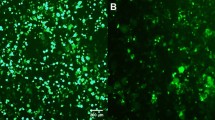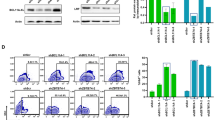Abstract
Diseases such as AIDS and cancers may require the introduction of multiple genes into either stem cells or nondividing cells, among others, for therapeutic purposes. Such genes may act at different points of the disease pathway, or may constitute a regulatory loop to bypass or rectify the defective gene or pathway underpinning the disease. Ideally, the therapeutic genes must be transduced together in diverse combinations, and the introduction should occur without constraints. Since lentiviral vectors can transduce both dividing and nondividing cells, they are ideal vehicles to investigate combinatorial gene transfer into diverse cells. In this study, we demonstrate that by using two independent lentiviral vectors, pseudotyped with the protein g of vesicular stomatitis virus, up to four genes can be introduced simultaneously into single dividing and nondividing cells. Up to 45% and 73% of dividing and nondividing cells, respectively, could be transduced with two lentiviral vectors. The efficiency of cotransducing a single cell was the product of the individual transduction efficiencies and suggested the absence of viral interference. Multiple and combinatorial gene transduction using lentiviral vectors may prove useful in gene therapy.
This is a preview of subscription content, access via your institution
Access options
Subscribe to this journal
Receive 12 print issues and online access
$259.00 per year
only $21.58 per issue
Buy this article
- Purchase on Springer Link
- Instant access to full article PDF
Prices may be subject to local taxes which are calculated during checkout






Similar content being viewed by others
References
Morgan RA et al. Retroviral vectors containing putative internal ribosome entry sites: development of a polycistronic gene transfer system and applications to human gene therapy Nucleic Acids Res 1992 20: 1293–1299
Ramesh N et al. High-titer bicistronic retroviral vectors employing foot-and-mouth disease virus internal ribosome entry site Nucleic Acids Res 1996 24: 2697–2700
Richardson JH, Hofmann W, Sodroski JG, Marasco WA . Intrabody-mediated knockout of the high-affinity IL-2 receptor in primary human T cells using a bicistronic lentivirus vector Gene Therapy 1998 5: 635–644
Marcello A, Giaretta I . Inducible expression of herpes simplex virus virus thymidine kinase from a bicistronic HIV1 vector Res Virol 1998 149: 419–431
Xu L, Yee JK, Wolff JA, Friedman T . Factors affecting long-term stability of Moloney murine leukemia virus-based vectors Virology 1989 171: 331–341
McLachlin JR et al. Factors affecting retroviral vector function and structural integrity Virology 1993 195: 1–5
Walker PS et al. Viral interference during simultaneous transduction with two independent helper-free retroviral vectors Hum Gene Ther 1996 7: 1131–1138
Bonura F et al. Inhibition of human immunodeficiency virus 1 (HIV-1) by variant B of human herpesvirus 6 (HHV-6) New Microbiol 1999 22: 161–171
Federico M et al. Anti-HIV viral interference induced by retroviral vectors expressing a nonproducer HIV-1 variant Acta Haematol 1996 95: 199–203
D'Aloja P et al. gag, vif, and nef genes contribute to the homologous viral interference induced by a nonproducer human immunodeficiency virus type 1 (HIV-1) variant: identification of novel HIV-1-inhibiting viral protein mutants J Virol 1998 72: 4308–4319
Volsky DJ et al. Interference to human immunodeficiency virus type 1 infection in the absence of downmodulation of the principal virus receptor, CD4 J Virol 1996 70: 3823–3833
Bernier R, Tremblay M . Homologous interference resulting from the presence of defective particles of human immunodeficiency virus type 1 J Virol 1995 69: 291–300
Mullins JI, Hoover EA, Quackenbush SL, Donahue PR . Disease progression and viral genome variants in experimental feline leukemia virus-induced immunodeficiency syndrome J Acquir Immune Defic Syndr 1991 4: 547–557
Guan M, Tudor G, Yang JY, Henderson EE . Structure and origin of HIV type 1 DNA in persistently infected B lymphoblastoid cell lines AIDS Res Hum Retroviruses 1997 13: 751–757
Potash MJ, Volsky DJ . Viral interference in HIV-1 infected cells Rev Med Virol 1998 8: 203–211
Zufferey R et al. Multiply attenuated lentiviral vector achieves efficient gene delivery in vivo Nat Biotechnol 1997 15: 871–875
Naldini L et al. Efficient transfer, integration, and sustained long-term expression of the transgene in adult rat brains injected with a lentiviral vector Proc Natl Acad Sci USA 1996 93: 11382–11388
Blomer U et al. Applications of gene therapy to the CNS Hum Mol Genet 1996 5: 1397–1404
Naldini L et al. In vivo gene delivery and stable transduction of nondividing cells by a lentiviral vector Science 1996 272: 263–267
Akkina RK et al. High-efficiency gene transfer into CD34+ cells with a human immunodeficiency virus type 1-based retroviral vector pseudotyped with vesicular stomatitis virus envelope glycoprotein G J Virol 1996 70: 2581–2585
Reiser J et al. Transduction of nondividing cells using pseudotyped defective high-titer HIV type 1 particles Proc Natl Acad Sci USA 1996 93: 15266–15271
Miyoshi H, Takahashi M, Gage FH, Verma IM . Stable and efficient gene transfer into the retina using an HIV-based lentiviral vector Proc Natl Acad Sci USA 1997 94: 10319–10323
Morgenstern JP, Land H . Advanced mammalian gene transfer: high titre retroviral vectors with multiple drug selection markers and a complementary helper-free packaging cell line Nucleic Acids Res 1990 18: 3587–3596
Smolich B et al. Cloning and biochemical characterization of LIMK-2, a protein kinase containing two LIM domains J Biochem (Tokyo) 1997 121: 382–388
Yang N et al. Cofilin phosphorylation by LIM-kinase 1 and its role in Rac-mediated actin reorganization Nature 1998 393: 809–812
Hart AR, Cloyd MW . Interference patterns of human immunodeficiency viruses HIV-1 and HIV-2 Virology 1990 177: 1–10
Chen BK, Saksela K, Andino R, Baltimore D . Distinct modes of human immunodeficiency virus type 1 proviral latency revealed by superinfection of nonproductively infected cell lines with recombinant luciferase-encoding viruses J Virol 1994 68: 654–660
Winslow BJ, Pomerantz RJ, Bagasra O, Trono D . HIV-1 latency due to the site of proviral integration Virology 1993 196: 849–854
Oostendorp RA, Knol EF, Verhoeven AJ, Scheper RJ . An immunosuppressive retrovirus-derived hexapeptide interferes with intracellular signaling in monocytes and granulocytes through N-formylpeptide receptors J Immunol 1992 149: 1010–1015
Martin RA, Nayak DP . Mutational analysis of HIV-1 gp160-mediated receptor interference: intracellular complex formation Virology 1996 220: 461–472
Federspiel MJ, Crittenden LB, Provencher LP, Hughes SH . Experimentally introduced defective endogenous proviruses are highly expressed in chickens J Virol 1991 65: 313–319
Kringstein AM, Rossi FM, Hofmann A, Blau HM . Graded transcriptional response to different concentrations of a single transactivator Proc Natl Acad Sci USA 1998 95: 13670–13675
Aiken C . Pseudotyping human immunodeficiency virus type 1 (HIV-1) by the glycoprotein of vesicular stomatitis virus targets HIV-1 entry to an endocytic pathway and suppresses both the requirement for Nef and the sensitivity to cyclosporin A J Virol 1997 71: 5871–5877
Reynolds BA, Tetzlaff W, Weiss S . A multipotent EGF-responsive striatal embryonic progenitor cell produces neurons and astrocytes J Neurosci 1992 12: 4565–4574
Gritti A et al. Multipotential stem cells from the adult mouse brain proliferate and self-renew in response to basic fibroblast growth factor J Neurosci 1996 16: 1091–1100
Acknowledgements
This research was supported by grants AI-39004 and AI-36214 (UCSD Center for AIDS Research). We thank Dr Inder Verma and Hiroyuki Miyoshi of the Salk Institute for providing us with vectors pHR′, Δ8.2 and pMDG; Dr David Chambers of the Flow Cytometry Laboratory, the Salk Institute, for FACs analyses and Dr Charlene Barroga for comments. We also thank Chris Goodwin and Tim Marsh for technical assistance.
Author information
Authors and Affiliations
Rights and permissions
About this article
Cite this article
Frimpong, K., Spector, S. Cotransduction of nondividing cells using lentiviral vectors. Gene Ther 7, 1562–1569 (2000). https://doi.org/10.1038/sj.gt.3301283
Received:
Accepted:
Published:
Issue Date:
DOI: https://doi.org/10.1038/sj.gt.3301283
Keywords
This article is cited by
-
In Situ Programming of CAR-T Cells: A Pressing Need in Modern Immunotherapy
Archivum Immunologiae et Therapiae Experimentalis (2023)
-
Secretion of a mammalian chondroitinase ABC aids glial integration at PNS/CNS boundaries
Scientific Reports (2020)
-
Recombinant elastin-based nanoparticles for targeted gene therapy
Gene Therapy (2017)
-
Doxycycline-regulated lentiviral vector system with a novel reverse transactivator rtTA2S-M2 shows a tight control of gene expression in vitro and in vivo
Gene Therapy (2003)



